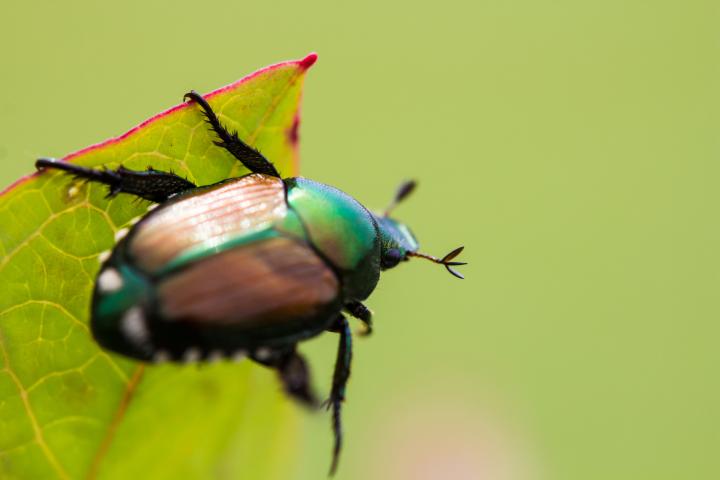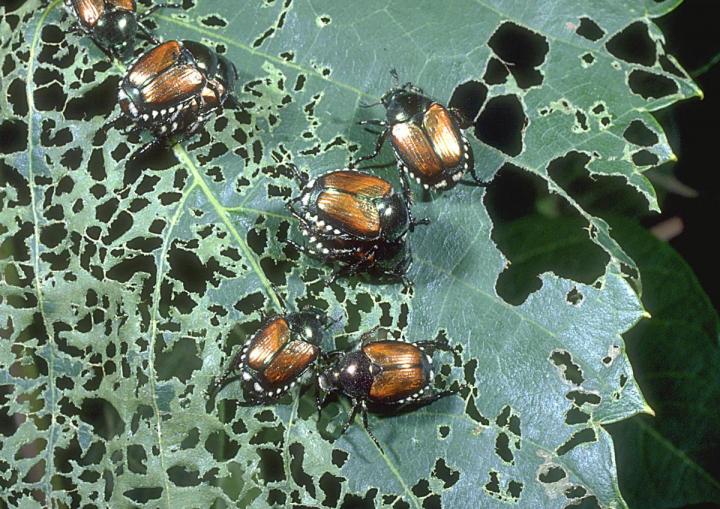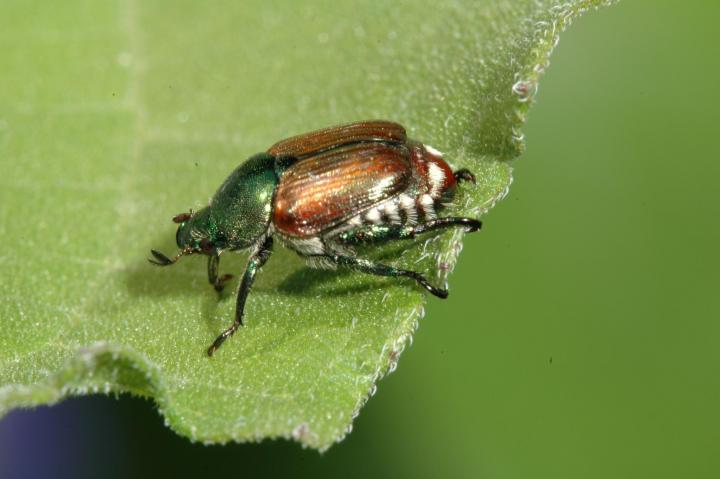
Use these tips to get rid of Japanese beetles.
Crestock
What are those green garden beetles? Here are tips on how to identify and get rid of Japanese beetles.
What are Japanese Beetles?
Japanese beetles are small bugs that carry a big threat. They do not discriminate on what types of plants to feed on. In fact, they are classified as a pest to hundreds of different species. They are one of the major insect pests in the Eastern and Midwestern United States, causing monumental damage to crops each year.
Prior to the beetle's accidental introduction into the United States earlier in this century, the Japanese beetle was found only on the islands of Japan, isolated by water and kept in check by its natural enemies. In 1912 a law was passed that made it illegal to import plants rooted in soil. Unfortunately, the failure to implement the law immediately allowed the Japanese beetle to arrive in this country.
Most entomologists agree that the beetles entered the country as grubs in soil on Japanese iris roots. In 1916 these coppery-winged pests were first spotted in a nursery near Riverton, New Jersey. By 1920 eradication programs were dropped; the beetle proved to be too prolific a breeder. Not a choosy eater, it dines on over 200 species of plants.
Identification
How to Identify Japanese Beetles
Japanese Beetles are ½ inch in length with metallic blue-green heads, copper backs, tan wings, and small white hairs lining each side of the abdomen. Japanese beetles usually feed in small groups. They lay eggs in the soil during June, which develop into tiny white grubs with brown heads and six legs that are up to ¾ inch in length. These grubs will remain under wraps for about 10 months and overwinter and grow in the soil.
They emerge from the soil as adult beetles and begin feeding in June. They usually attack plants in groups, which is why damage is so severe. Although the lifecycle of the adult Japanese beetle is barely 40 days, it can cover a lot of ground. Even if you succeed in controlling your Japanese beetle population, your neighbor’s Japanese beetles might come on over.
Japanese Beetle Damage
Japanese beetles eat a wide variety of flowers and crops (the adult beetles attack more than 300 different kinds of plants), but they are especially common on roses, beans, grapes, and raspberries. They can devour most of the foliage on favored plants like roses. Look for leaves that are “skeletonized” (only have veins remaining). This is a tell-tale sign of Japanese Beetles. Mexican Bean Beetles can also leave foliage skeletonized, though, so be sure to identify them by their appearance as well.
Grubs damage grass when overwintering in the soil, as they eat the roots of lawn grasses and garden plants.

Control and Prevention
How to Get Rid of Japanese Beetles
Good horticultural practices, including watering and fertilizing, will reduce the damage caused by these beetles, but oftentimes you simply need to get rid of them. Here are some ideas:
- Row Covers: Protect your plants from Japanese beetles with row covers during the 6- to 8-week feeding period.
- Hand Pick: Unfortunately, the most effective way of getting rid of Japanese beetles is to hand pick them. It’s time consuming, but it works, especially if you are diligent. When you pick them off, put them in a solution of 1 tablespoon of liquid dishwashing detergent and water, which will cause them to drown.
- Neem oil: Neem oil and sprays containing potassium bicarbonate are somewhat effective, especially on roses. The adults ingest a chemical in the neem oil and pass it on in their eggs, and the resulting larvae die before they become adults. Neem can be harmful to fish and should be reapplied after rainstorms.
- Use a Dropcloth: Put down a dropcloth and, in the early morning when they’re most active, shake them off and dump them into a bucket of soapy water. They will not survive.
- Insecticides: If you wish to spray or dust with insecticides, speak to your local cooperative or garden center about approved insecticides in your area.
- Or, try this safe homemade solution: Mix 1 teaspoon of liquid dishwashing detergent with 1 cup of vegetable oil and shake well; then add it to 1 quart of water. Add 1 cup of rubbing alcohol and shake vigorously to emulsify. Pour this mixture into a spray bottle and use it at ten-day intervals on pests. Homemade sprays can run more of a risk of damaging plant leaves, so be careful.
- Apply sprays in the morning, never in full sun or at temperatures above 90ºF. If your plants start to wilt, rinse the leaves immediately with clean water.
- Traps: Japanese beetle traps can be helpful in controlling large numbers of beetles, but they also might attract beetles from beyond your yard. Eugenol and geraniol, aromatic chemicals extracted from plants, are attractive to adult Japanese beetles as well as to other insects. Unfortunately, the traps do not effectively suppress adults and might even result in a higher localized population. If you want to try them, be sure to place traps far away from plants so that the beetles do not land on your favored plants on their way to the traps.
- Fruit Cocktail: You can buy Japanese beetle traps of all sorts, but most are no more effective than a can of fruit cocktail. Open the can and let it sit in the sun for a week to ferment. Then place it on top of bricks or wood blocks in a light-colored pail, and fill the pail with water to just below the top of the can. Place the pail about 25 feet from the plants you want to protect. The beetles will head for the sweet bait, fall into the water, and drown. If rain dilutes the bait, start over.
- Geraniums: Japanese beetles are attracted to geraniums. They eat the blossoms, promptly get dizzy, fall down, and permit you to dispose of them conveniently with a dustpan and brush. Plant geraniums close to more valuable plants which you wish to save from the ravages of Japanese beetles.
- Japanese beetles on Roses? Note that insecticides will not fully protect roses, which unfold too fast and are especially attractive to beetles. When beetles are most abundant on roses, nip the buds and spray the bushes to protect the leaves. When the beetles become scarce, let the bushes bloom again. Timeliness and thoroughness of application are very important. Begin treatment as soon as beetles appear, before damage is done.
NOTE: Many dusts or sprays are highly toxic to honeybees. If application of these materials to plants is necessary during the bloom period, do not apply during hours when bees are visiting the flowers. If larger than yard and garden plantings are to be treated, you may need to contact nearby beekeepers in advance so that they can protect their colonies.

How to Prevent Japanese Beetles
Unfortunately, there is no magic potion to get rid of this pest. For general preventive maintenance, experts recommend keeping your landscape healthy. Remove diseased and poorly nourished trees as well as any prematurely ripening or diseased fruits, which can attract Japanese beetles. Try these tips:
- Select plants that Japanese Beetles will not be attracted to. See our list of Best and Worst Plants for Japanese Beetles. Dispersing their favorite plants throughout the landscape, rather than grouping them together, also can help.
- In the grub stage of late spring and fall (beetles have two life cycles per season), spray the lawn with 2 tablespoons of liquid dishwashing soap diluted in 1 gallon of water per 1,000 square feet. The grubs will surface and the birds will love you. Spray once each week until no more grubs surface.
- You can introduce the fungal disease milky spore into your lawn to control the Japanese beetle larvae population. The larvae ingest the spores as they feed in the soil. The spore count must be up for two to three years for this method to be effective. Fortunately, the spores remain viable in the soil for years. This is an expensive treatment, as all the soil within five-eights of a mile needs to be treated for good control.
- You can also drench sod with parasitic nematodes to control the larvae. The nematodes must be applied when the grubs are small and if the lawn is irrigated before and after application. Preparations containing the Heterorhabditis species seem to be most effective.
- Companion planting can be a useful strategy in preventing pests. Try planting garlic, rue, or tansy near your affected plants to deter Japanese beetles.
- You can also attract native species of parasitic wasps (Tiphia vernalis or T. popilliavora) and flies to your garden, as they are natural predators of the beetles. They will probably attack the larve, but they are not ery effective in reducing the overall beetle population.
Plants Affected
- Roses
- Beans
- Grapes
- Raspberries








